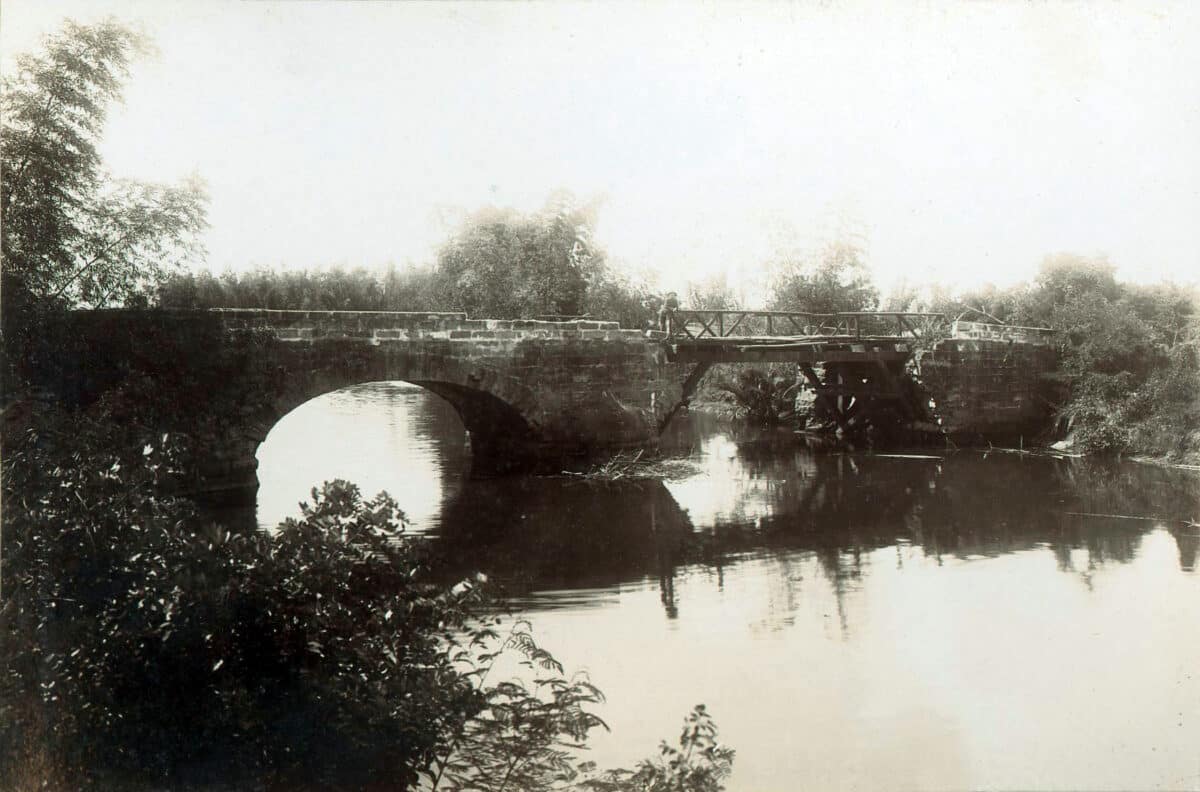August 1899: Philippine-American War south of Manila and in the Visayan Islands

Zapote River Bridge in 1899 / Image: Wikipedia
Most general summaries of the Philippine-American War only focus on the fighting north of Manila. However, there was significant fighting south of Manila that hardly gets mentioned except for a few battles after the war broke out on February 4, 1899.
Just like the fighting in the north, the fighting south of Manila commenced on February 4, 1899. The Americans did have an advantage in the south because Cavite Province bordered Manila Bay.
The water of Manila Bay provided many large, medium and small American naval vessels with mobility and maneuverability in the inlets and rivers flowing into the bay. This mobility allowed the ships and boats to fire light, medium and heavy artillery bombardment at Filipino revolutionary positions.
Another unique feature of the fighting in the south was the combination of American forces. It was not uncommon that American blue jackets (US Navy personnel), US Marines and US Army units fought together especially on internal waterways and bays. A joint US Marine and Army operation captured the town of Imus in Cavite Province.
In April 1899, Major General Henry Lawton captured Santa Cruz, the capital of Laguna Province. His forces also controlled Laguna de Bay and several surrounding provinces.
The Americans had a major problem initially with the fighting in the south. Once the Americans had defeated the revolutionaries on the battlefield, the United States forces would give up ground and head back to the comforts of Manila. The “defeated” Filipinos would reoccupy the territory that they had supposedly lost earlier.
To defeat the revolutionary forces south of Manila, the Americans needed to establish forward operating bases with soldiers who interacted with the local population. To win the hearts and minds of the local citizens, the soldiers needed to be present and committed to an area. Enjoying good food and a comfortable bed in Manila would not get the job done. In addition, the American soldiers needed to offer benefits like education, public health and health care to the Filipino citizens.
By October 1899, the Filipino revolutionary resistance in Cavite and the surrounding provinces had collapsed. Major General Loyd Wheaton had won a major victory at the Battle of Zapote River in Bacoor in Cavite Province on June 13, 1899.
In the general summaries of the Philippine-American War, there is even less focus on the fighting in the Visayan and other southern islands. The initial focus was the Island of Luzon since it contained Manila, the capital of the Philippines, Malolos, the first governing capital, and most of the Philippine revolutionary troops.
In the Visayan Islands, the United States Navy led the offensive action against the Filipino revolutionary forces. When needed, the US Marines and US Navy blue jackets attacked the revolutionary forces on shore. The USS Boston and USS Petrel fired on Ilolio on Panay Island, and the US. Petrel attacked Cebu. The revolutionary forces in Cebu and Iloilo were defeated in conventional fighting, but they changed to guerrilla strategy and tactics. This transformation in strategy and tactics was months prior to the changes in Luzon.
Interestingly, the island of Negros offered little to no resistance to American occupation. Most of the leaders of the island accepted American rule.
Shortly after the defeat of Cebu and Iloilo, the United States established the Visayan Military District to administer and control Panay Island (Iloilo), Cebu and Negros.
In Mindanao and Sulu, the Christian Filipinos fought against American annexation. The Muslim Filipinos did not resist American annexation. A peace treaty was negotiated between the United States and the Muslims which essentially pacified the Muslims. The treaty was called the Bates Treaty since General John Bates negotiated the treaty with the Sultan of the Muslim areas. Based on the terms of the treaty, the Sultan received compensation.
When reviewing the history of the Philippine-American War, it is imperative to study more than just the fighting to the north of Manila in 1899. The conflict south of Manila and in the Visayan Islands had substantial elements of guerrilla warfare long before President Emilio Aguinaldo ordered the tactical change in November 1899. Also, the conflict in the Visayan Islands, Mindanao and Sulu had components of a civil war, which were also present in Luzon.
Dennis Edward Flake is the author of three books on Philippine-American history. He is a Public Historian and a former park ranger in interpretation for the National Park Service at the Eisenhower National Historic Site in Gettysburg, PA. He can be contacted at: flakedennis@gmail.com

